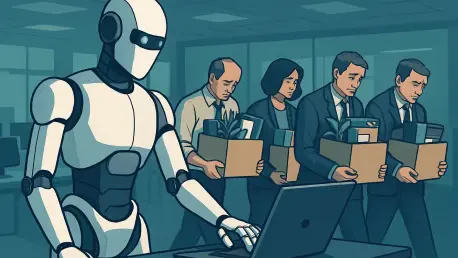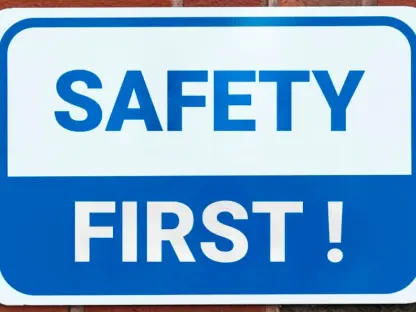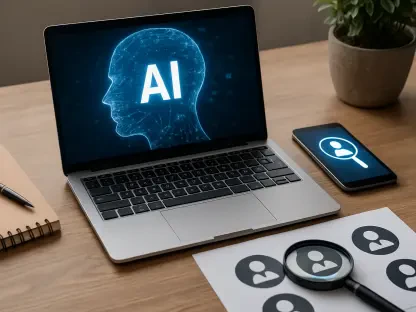As technology races forward at an unprecedented pace, a staggering prediction has emerged from recent surveys of business leaders across the United States, suggesting that artificial intelligence (AI) could reshape the workforce in ways previously unimaginable. A comprehensive report indicates that by the end of next year, nearly 4 in 10 companies might replace human workers with AI-driven solutions, a shift that could redefine job roles and industries overnight. This looming transformation raises critical questions about the balance between automation and employment, the types of roles most at risk, and the skills needed to navigate this new landscape. With economic pressures mounting and technological adoption accelerating, the implications for both employees and employers are profound, demanding a closer examination of how this trend is unfolding and what can be done to prepare for the inevitable changes on the horizon.
The Rising Tide of AI in Business Operations
Current Adoption Rates and Future Projections
The integration of AI into business operations has already begun to alter the employment landscape, with a significant number of companies embracing automation to streamline processes. According to a survey of 1,000 U.S. business leaders, nearly 3 in 10 organizations have replaced jobs with AI tools as of this year, and projections suggest that 37% expect to follow suit by the end of 2026. This rapid shift, anticipated to intensify over the next 18 to 24 months, marks a pivotal moment in labor market dynamics, outpacing changes seen in recent decades. Routine, process-driven roles face the highest risk of displacement, as companies prioritize efficiency and cost reduction. The data paints a clear picture of a workforce on the brink of transformation, where adaptability to technological advancements becomes not just an asset but a necessity for survival in an increasingly automated environment.
Beyond the immediate statistics, the broader implications of this trend reveal a dual narrative of challenge and opportunity. While AI displaces workers in repetitive tasks, it simultaneously creates demand for new roles in areas such as AI oversight, data ethics, and human-AI collaboration. Experts highlight that this transition is less about outright job loss and more about job evolution, where the focus shifts to managing and enhancing AI systems. However, the speed of adoption leaves little room for complacency, as businesses race to implement these technologies to maintain competitive edges. The coming months will likely serve as a critical testing ground, determining whether the workforce can pivot quickly enough to meet the demands of this tech-driven era or if significant gaps in employment will emerge as a result.
Economic Drivers Behind Workforce Reductions
Economic uncertainty, coupled with the push for automation, stands as a primary catalyst for workforce reductions across various sectors. Surveys indicate that half of business leaders have scaled back hiring efforts, while 39% have already conducted layoffs this year, with 35% expecting more by year-end and 58% anticipating further cuts in 2026. High-salary employees, those without AI proficiency, recently hired staff, and entry-level workers are identified as the most vulnerable groups. The rationale often centers on immediate payroll savings by targeting higher-cost roles, while the lack of technical skills exposes others to replacement by more efficient automated systems. This reflects a broader shift toward leaner, tech-ready teams where traditional career paths and tenure take a backseat to adaptability and digital competence.
The consequences of these economic decisions extend beyond mere numbers, impacting morale and long-term organizational stability. A pattern of “serial layoffs”—rapid, successive workforce cuts—has emerged as a reactive strategy among some HR leaders, often leading to unintended fallout such as diminished employee confidence and loss of critical expertise. This short-term focus on cost-cutting through AI adoption risks creating a workforce that feels expendable, potentially undermining loyalty and productivity. While automation offers undeniable efficiencies, the human cost of such transitions cannot be overlooked, as companies must weigh immediate financial gains against the sustainability of their talent pools in a rapidly changing economic climate.
Preparing for an AI-Driven Future
The Critical Role of Reskilling and Upskilling
As AI continues to disrupt traditional job roles, the urgency for reskilling and upskilling has never been more apparent, with both technical and soft skills emerging as essential tools for navigating the future. Professionals are encouraged to learn AI-related technologies to remain relevant, but technical expertise alone is not enough to secure a foothold in this evolving market. Skills like adaptability, critical thinking, and emotional intelligence are equally vital, enabling workers to differentiate themselves in environments where human judgment complements machine efficiency. Employers, too, bear responsibility to invest in training programs that enhance both digital literacy and human-centric capabilities, fostering engagement and retention amid widespread uncertainty about job security.
The scope of reskilling extends beyond individual initiative, requiring a collaborative effort between workers, businesses, and educational institutions to bridge the skills gap. Industry leaders emphasize that proactive training can transform potential displacement into opportunity, equipping employees to handle emerging roles tied to AI innovation. Government and private sector partnerships could play a pivotal role in funding and scaling these initiatives, ensuring that the workforce is not left behind as automation advances. Without such measures, the risk of a widening divide between those prepared for an AI-driven economy and those left vulnerable grows, potentially exacerbating social and economic inequalities in the years ahead.
Balancing Automation with Workforce Stability
The broader implications of AI-driven workforce changes reveal a complex interplay between technological progress and human capital, with varying perspectives on the severity of job market disruption. While some HR leaders resort to short-term layoffs as a quick fix, this approach often erodes morale and strips organizations of valuable skills, highlighting the pitfalls of reactive management. In contrast, insights from economic analyses suggest a more tempered outlook, with many companies opting to train existing staff to use AI tools rather than replace them outright. This strategy points to a potential middle ground where automation enhances rather than eliminates roles, provided there is a commitment to strategic workforce planning over impulsive cost-cutting.
Reflecting on the past trajectory of these trends, it became evident that the rush to adopt AI had sparked both alarm and optimism among stakeholders. The challenge had been to anticipate the scale of displacement while recognizing the potential for new job categories to emerge. Companies that had prioritized training over termination often saw better outcomes in employee retention and innovation. Looking ahead, the focus must shift to actionable solutions—scaling upskilling programs, fostering public-private partnerships, and encouraging policies that support lifelong learning. By investing in human potential alongside technological advancement, businesses and workers alike can navigate the uncertainties of automation, ensuring that the benefits of AI are shared broadly across the labor market.









